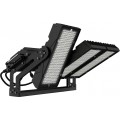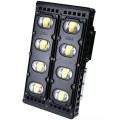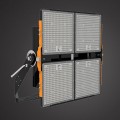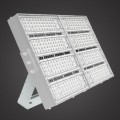Illumination of sports fields is referred to as sports lighting. Throughout the years, we have witnessed increases in the demand for both indoor and outdoor sports facilities. The purpose of lighting for sports is to provide a satisfactory luminous environment that makes a contribution to the visibility of the playing target (ball), the competitors and the surrounding backgrounds. Sports fields for baseball, football, or other sports activities may be illuminated by artificial light with the intention to allow game play during the night time. So as to do that, uniformly distributed lighting is required on the arena and in the space above the playing field. To accomplish this objective, both quantitative and qualitative factors of illumination should be taken into account.

Qualitative factors
Illumination of sports venues including football fields, soccer fields, baseball fields, and tennis courts is complicated. Generally speaking, artificial lighting is required to illuminate the playing field, the athletes and officials on the field, and the ball (e.g. baseball or football) while it's in play. Visibility is simply one initial basic concern. Other considerations such as attainment of a specific level of illumination; distribution of light; uniformity of illuminance in various regions of the playing area measured in uniformity ratio (UR); color rendering index (CRI), color contrast (CC) and modeling. luminaire efficiencies; beam patterns of the delivered illumination; effects of light trespass or spill light (e.g., light on neighboring areas); human perception of opposing players; revealing the spin of a ball and its path of travel; glare; cost of lighting installations; life-cycle costs of lamps; and many other aspects of lighting all should be considered.
Light quality
Sports lighting is a form of wide-area lighting, usually must meet specific lighting criteria to comply with specifications that are often required for a particular location or application. As an example, lighting designers have learned that the size and speed of an object significantly impacts the ability of a person to locate and detect an object. Thus objects such as a football or baseball, which are smaller sized and can move at high velocities as compared to a player, are much more difficult to see under low or reduced lighting conditions. Organizations such as the Illuminating Engineering Society of North America (IESNA) and others have established sports field illumination intensity and uniformity minimums for different sports that are frequently used for these purposes. Many customers require that such standards be met by the company installing the sports lighting system. Uniformity is a way of measuring relationships of the illuminance over an area. The lighting designer, many times with the aid of a computer program, selects the quantity and type of lights to meet the values that are applicable for a field. The field of sports lighting has continued to develop with time into a form of outdoor lighting having characteristics much like outdoor area lighting yet distinct to those requirements that come into play when lighting athletic playing fields. Uniformity of illuminance is of vital importance as is illumination level as such with these factors being coupled by the ever present demand for optimum performance at the smallest possible cost. In the sports light field especially both vertical and horizontal illuminances must also be addressed as must illumination levels necessary for optimum video camera operation inter alia. Luminaire design also generally takes under consideration conventional arrangements of pole locations, mounting heights and aiming angles. Other desired goals include consistent overlap of beam patterns with the intention to take full advantage of system performance while cutting down costly applications engineering efforts usually concerned with sports lighting systems.
Light pollution
In quite recent times, substantial effort has moved into the development of approaches to counter-act spill and glare light concerns in wide area lighting installations. As lighting technology continuously make improvements, more precise aiming and focusing of lighting on the ground zone contributes to less on-field glare and in addition less unwanted uplight, spill, and general glare. Glare and spill light, and halo effect light, are known as as light pollution. Glare is the sensation created by luminances within the visual field highly in excess of the luminance to which the eyes are adapted. The four contributing factors are solid angle size of the source, position of the light source, average luminance of the entire field of view, as well as amount of light source locations in the area of view. Therefore it's very clear that lighting that provides efficient transient uplighting that is precisely aimed in avoiding glare and spill issues and that does not contribute appreciably to sky glow or other undesired conditions is desirable in the industry. To satisfy glare and spill requirements, illumination levels above the playing field may be attenuated to the extent it impacts playability. By playability, it implies that there exists insufficient illumination of the volume of space, or parts of it, above a playing field for the players to follow, for instance, the flight of a ball. Glare and spill light control frequently requires attenuation or redirection of light, which can eliminate or prevent light from adequate illumination of associated aerial space.
HID light sources
Sports fields are typically lit up with high intensity discharge (HID) lamps which include, but are not confined to, fluorescent, sodium (HPS), metal halide (MH), mercury vapor (HgV), and low pressure sodium (LPS). metal halide gas discharge lamps have several desirable characteristics, such as a good color balance suitable for indoor lighting (as opposed to mercury vapor and sodium lamps), high luminous output (e.g., over 100 k lm), superior luminous efficacy (e.g., around 100 .mu.m/W), outstanding color rendering (e.g., CRI of 65 or more), and ability to emulate natural light (e.g., CCT around 4200K), and relatively efficient operation. They are widely applied in many applications such as industrial lighting and sports lighting. Over the years the art of designing wide-area HID lighting systems has progressed to cope with issues such as maintaining minimum light levels, delivering selected lighting uniformities, and alleviating glare so as to satisfy various safety, playability, or light pollution concerns, for example.
Cost concerns
While high wattage HID lamps produce a substantial amount of light, the lamps can be large (e.g., over 300 mm long and over 200 mm in diameter) and frequently necessitate large and complex optical devices to harness the light and direct it towards the target area; this increases cost and size to the luminaire. Increasing the size of the luminaire often times increases wind loading (i.e., drag) and weight; as a result the elevating structure (e.g., pole) has to be more substantial, which in turn adds to cost. metal halide lamps may readily consume large volumes of energy per hour. Furthermore, a typical HID lamp life is at least thousands of hours, generally in the range of 3,000. Also, lumen depreciation to unsatisfactory levels at one-third of normal lamp life (e.g. at roughly 1000 hours of operation for a 3000 rated life lamp) either forces the customer of the lighting system to pay out the cost of replacement or to suffer unsatisfactory light levels for a potentially lengthy time. Economics plays a huge part in most sports lighting. Prime sports lighting customers include institutions such as school districts, municipal recreation departments, and private sports leagues. Such entities are especially sensitive to cost.
LED
Substantial efforts have invested into cutting down sport lighting system costs. Solid-state light sources are renowned for energy efficiency and durability. Light-emitting diodes (LEDs) are an appealing alternative light source since they have a much much longer operating life than HIDs (e.g., tens of thousands of hours) and an efficacy equivalent to or exceeding HIDs. LED lights can be dimmed, a desired light level can be consistently obtained through the useful lifetime of the lamps. They can be made to have many different color properties. A wide-area lighting system making use of a plurality of LEDs comes with the potential to illuminate complex target areas in a manner not readily realized by using state-of-the-art HID lamps. The cabability to use very narrow beams enables not only illumination of distant portions of the playing fileld, but also crossing of luminaire aimings to ensure that lights from different luminaires can blend (or meet from contrasting angles). Hence, light from different luminaires can illuminate the same spot to develop modeling. Modelling is a highly desirable attribute for all sports lighting systems given that lighting that reveals the depth, shape, and texture of an object or person is preferred. The ability to switch an LED light on and off instantly enables sports venues to be illuminated only when in operation. HID lights need to have awarm-up period of several minutes before providing serviceable light. Thus it isn't feasible to use conventional lights for intermittent lighting.
While changes from conventional lighting have raised concerns for uplighting, at the same time, the restrictions of conventional lighting in terms of their spectral power distribution (SPD) have long been acknowledged. For these solid-state light sources, the junction temperature, drive current, voltage differential, and other factors could affect the rate of degradation. The junction temperature of the LED is a function of the amount of power consumed by operation of the LED with regards to the quantity of heat rejected to the LED's surroundings. Above this critical temperature, the operation life of the LED is reduced as a result of thermal degradation. LEDs are rated with regards to allowable power usage and also allowable junction temperature which can be plotted versus expected longevity. Therefore, there is a need in the art for sports and other wide-area lighting systems that take advantage of the benefits of LEDs while addressing heat management and drop, and yet, still prove cost-effective in comparison to the traditional HID systems.






























